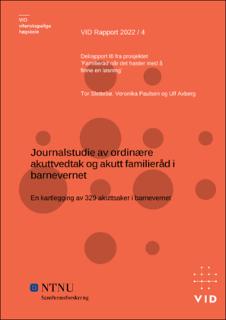| dc.contributor.author | Slettebø, Tor | |
| dc.contributor.author | Paulsen, Veronika | |
| dc.contributor.author | Axberg, Ulf | |
| dc.date.accessioned | 2022-10-21T06:43:33Z | |
| dc.date.available | 2022-10-21T06:43:33Z | |
| dc.date.created | 2022-10-20T14:27:12Z | |
| dc.date.issued | 2022 | |
| dc.identifier.isbn | 978-82-8456-014-4 | |
| dc.identifier.uri | https://hdl.handle.net/11250/3027443 | |
| dc.description.abstract | In this report we present the main findings from a study comparing emergency cases in which ordinary emergency decision-making was used, with cases in which an emergency family group conferences (FGCE) were held. The empirical data is based on client records, altogether 329 records of emergency cases in child protection. 270 of these were ordinary emergency cases and 59 were FGCEs. The findings are to be viewed in the context of the summary of findings from the qualitative study presented at the beginning of this report.
It must be stressed that this does not provide a basis for generalisation. Nevertheless, we believe that the survey identifies some important trends. The lack of studies on the use of FGCs makes it difficult to compare the findings with other research.
Overall, findings from the study of client records support the findings from the qualitative interviews and demonstrate that the use of FGC in acute situations leads to greater mobilisation of relatives and networks, which better facilitates less-intrusive solutions for children in emergency situations. The findings from our study show that the use of FGC in acute situations creates impetus to find solutions among relatives and networks, leading to a decrease in the use of government measures in both the short and long term. The use of FGCE also appears to contribute to making the acute situation less dramatic and traumatic, and thereby reduces levels of insecurity in children and parents. This is related to the fact that children can be with someone they know, while providing them and their parents with more information and greater understanding of what is about to happen. This creates a greater sense of control and predictability for both children and parents, which reduces the levels of stress in the acute situation while preparing them for a possible relocation.
Finally, we would like to mention that the qualitative study also identified challenges in the use of FGCEs, particularly when suspected violence and/or abuse is involved. In such cases, ordinary FGC should be considered, as well as 'shuttle councils' adapted to CWS cases involving violence and high levels of conflict. We are also critical of the use of FGC when children lack trust in the adults in the family and thus do not want to partake in a FGC. | en_US |
| dc.description.sponsorship | Prosjektet er finansiert av Barne- ungdoms- og familiedirektoratet (Bufdir). | en_US |
| dc.language.iso | nob | en_US |
| dc.publisher | VID vitenskapelige høgskole | en_US |
| dc.relation.ispartof | VID Rapport | |
| dc.relation.ispartofseries | VID Rapport;2022/4 | |
| dc.subject | Barnevern | en_US |
| dc.subject | Child care | en_US |
| dc.subject | Familievernet i Norge, statlig | en_US |
| dc.subject | National Family therapy services in Norway | en_US |
| dc.subject | akuttvedtak | en_US |
| dc.subject | familieråd | en_US |
| dc.title | Journalstudie av ordinære akuttvedtak og akutt familieråd i barnevernet. En kartlegging av 329 akuttsaker i barnevernet. Delrapport III fra prosjektet ‘Familieråd når det haster med å finne en løsning’ | en_US |
| dc.type | Research report | en_US |
| dc.description.version | publishedVersion | en_US |
| dc.rights.holder | Forfatteren har opphavsrettighetene til rapporten. Nedlasting for privat bruk er tillatt. Mangfoldiggjøring, videresalg av deler eller hele rapporten er ikke tillatt uten avtale med forfatterne eller Kopinor. | en_US |
| dc.source.pagenumber | 75 | en_US |
| dc.source.volume | 2022 | en_US |
| dc.source.issue | 4 | en_US |
| dc.identifier.cristin | 2063315 | |
| cristin.ispublished | true | |
| cristin.fulltext | original | |
